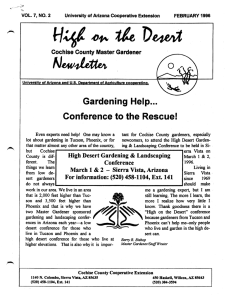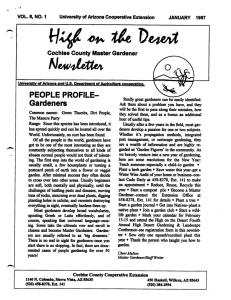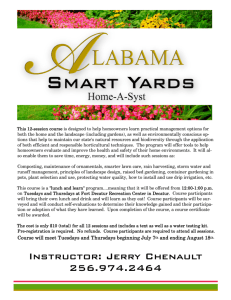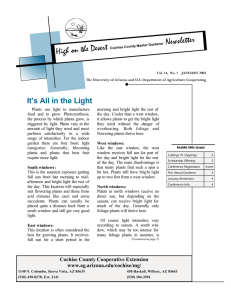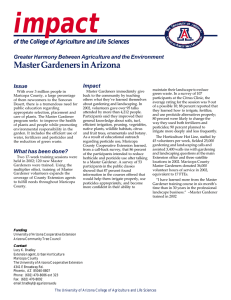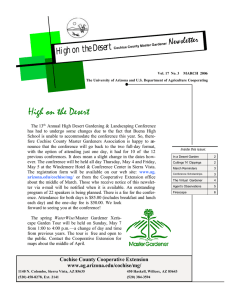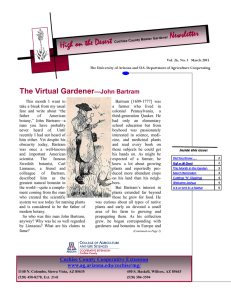Newsletter High on the Desert
advertisement
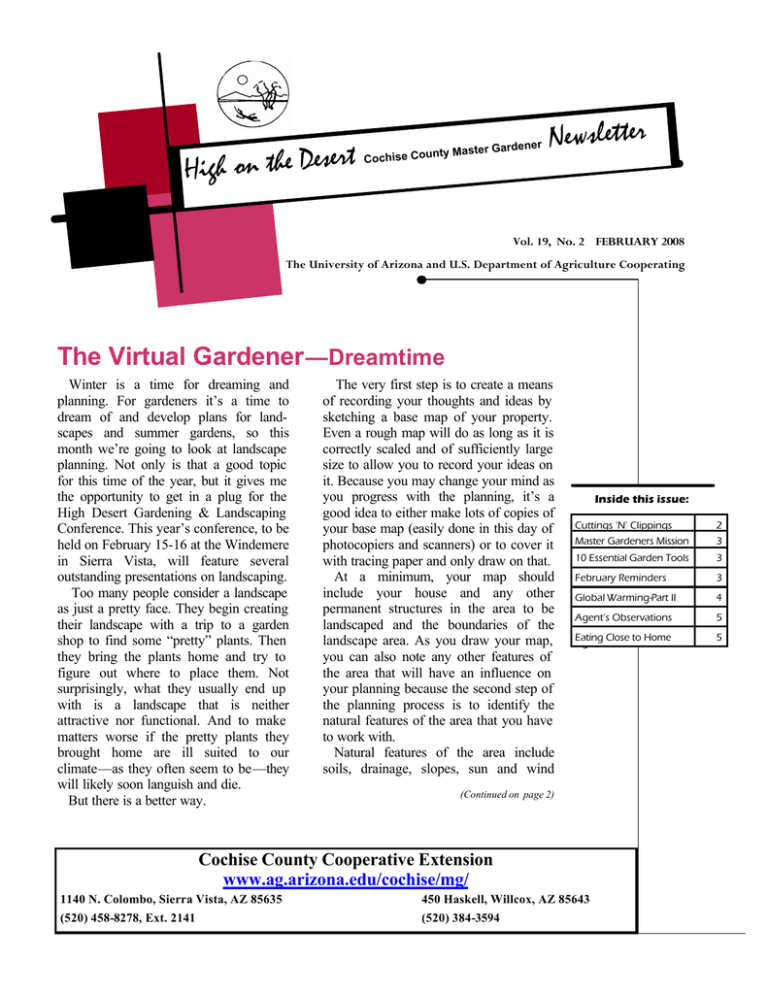
High on the Desert r Cochise r Gardene County Maste Newsletter Vol. 19, No. 2 FEBRUARY 2008 The University of Arizona and U.S. Department of Agriculture Cooperating The Virtual Gardener —Dreamtime Winter is a time for dreaming and planning. For gardeners it’s a time to dream of and develop plans for landscapes and summer gardens, so this month we’re going to look at landscape planning. Not only is that a good topic for this time of the year, but it gives me the opportunity to get in a plug for the High Desert Gardening & Landscaping Conference. This year’s conference, to be held on February 15-16 at the Windemere in Sierra Vista, will feature several outstanding presentations on landscaping. Too many people consider a landscape as just a pretty face. They begin creating their landscape with a trip to a garden shop to find some “pretty” plants. Then they bring the plants home and try to figure out where to place them. Not surprisingly, what they usually end up with is a landscape that is neither attractive nor functional. And to make matters worse if the pretty plants they brought home are ill suited to our climate—as they often seem to be—they will likely soon languish and die. But there is a better way. The very first step is to create a means of recording your thoughts and ideas by sketching a base map of your property. Even a rough map will do as long as it is correctly scaled and of sufficiently large size to allow you to record your ideas on it. Because you may change your mind as you progress with the planning, it’s a good idea to either make lots of copies of your base map (easily done in this day of photocopiers and scanners) or to cover it with tracing paper and only draw on that. At a minimum, your map should include your house and any other permanent structures in the area to be landscaped and the boundaries of the landscape area. As you draw your map, you can also note any other features of the area that will have an influence on your planning because the second step of the planning process is to identify the natural features of the area that you have to work with. Natural features of the area include soils, drainage, slopes, sun and wind Inside this issue: Cuttings ‘N’ Desert Clippings High on the Master Gardeners Mission 10 Essential Garden Tools February Reminders Frost Protection Global Warming-Part II Conference Scholarship Agent’s Observations November Reminders Eating Close to Home Agent’s Observations (Continued on page 2) Cochise County Cooperative Extension www.ag.arizona.edu/cochise/mg/ 1140 N. Colombo, Sierra Vista, AZ 85635 450 Haskell, Willcox, AZ 85643 (520) 458-8278, Ext. 2141 (520) 384-3594 32 33 3 3 3 4 4 4 5 4 5 5 PAGE 2 (Continued from page 1) exposure, and anything else that will influence your design. The natural features fall into two categories. Some provide opportunities you can exploit while others present constraints that will limit what you can do. Which features fall into which category depends on what you want to do. A rocky slope, for example, can add visual interest to an otherwise plain area and provde the venue for a rock garden. On the other hand, the slope could be a major constraint if you wanted to plant a lawn in the area. (Not that I am advocating lawns!) Once you have your map and have identified the features of your area that will influence your design, it’s time to begin thinking about what you want the landscape to do for you. Think of exterior (landscape) design in the same terms as interior (house) design. When designing a house the first thing to consider are the basic functional requirements that have to be accomodated. A house is a collection of specialized areas— areas for sleeping, a cooking, bathing, relaxing, entertaining, laundering, etc. Once you have identified all the areas you want to include in the house, then you Robert E. Call Extension Agent, Horticulture Carolyn Gruenhagen Editor can start thinking about how big each has to be, how they will be arranged, how you will get from one area to another, and so on. Designing a landscape is similar. Think of a landscape as a set of specialized areas that provide locations for different functions and activities, in other words rooms. Which functions and activities your landscape needs to support depends on you. You will probably always have a requirement for places to store trash containers and park vehicle(s) but other requirements will vary depending upon your needs. Other requirements may include areas for dining, cooking, entertaining, recreation, relaxing, vegetable gardening, flower gardening, pets, hobbies, etc. In short, anything that you might want to do outdoors. Once you have identified all the functions you want your landscape to perform, you can decide how big each area needs to be, where each is going to be located, and how you will move between them. Now, and only now, that you have the functional requirements identified, you are ready to begin thinking about the elements that will go into creating your design— hardscaping and plantings. The qualities of these elements include colors, lines, shapes, textures, and scale. Combining them in artful ways using unity, balance, transition, proportion, rhythm, focalization, repetition, and simplicity is what gives beauty to your landscape. To learn how to make these combinations, check out the article on landscape design principles at University of Florida’s Cooperative Extension Web site http://edis.ifas.ufl.edu/MG086. It provides one of the best discus- Cuttings ‘N’ Clippings T The next CCMGA meeting is 5:00 p.m. Thursday, February 7, 2008 in Public Meeting Room at UAS. T The free Water Wise lecture will be held February 2, 2008 at UAS in the Public Meeting Room from 9:00—11:00 a.m. Water Wise Landscapes in 5 Easy Steps—Come learn how to put all the elements together to create a beautiful, low maintenance and water efficient landscape. Elements include design, plant use, alternative water sources and more. Cyndi Wilkins, Instructional Specialist, UA Extension Water Wise Program will be the speaker. For information on upcoming lectures call Cado Daily at 458-8278, Ext. 2139 or go to www.ag.arizona.edu/cochise/ waterwise T A free tree pruning demo will be held Saturday, February 23. Call the Cooperative Extension office for information and location. Everyone is welcome. sions of both aesthetics and functional design principles I have found on the Web. While many landscape design sites are narrowly focused on selecting specific plants and designing landscapes for a particular area, this one provides guidance that is applicable anywhere. Until next time…Happy Surfing! Gary A. Gruenhagen, Master Gardener virtualgardener@cox.net PAGE 3 What Master Gardeners Do The primary mission of Cochise County Master Gardeners is to educate local residents on gardening including native plants and landscaping and to provide assistance with gardening-related questions. In addition, your Cochise County Master Gardeners: 4 Answer several thousand questions from the public every year 4 Publish a monthly newsletter for free that goes out to over 900 subscribers 4 Maintain a popular web site at www.ag.arizona.edu/cochise/mg 4 Sponsor an annual High Desert Gardening & Landscaping Conference 4 Assist the University of Arizona with field trials to test water requirements for plants, and to determine which plants are susceptible to Texas root rot 4 Donate gardening and landscaping books to the Cochise County Library System 4 Answer gardening questions at the Sierra Vista and Bisbee Farmers Markets 4 Provide speakers for organizations who are interested in gardening programs 4 Promote water conservation and the use of native or desert oriented plants 4 Docent the semiannual Water Wise Xeriscape tours 4 Provide scholarships when funds allow 4 Provide lists of plants specifically recommended for our area to new and current residents, local builders, and landscaping firms 4 Help fund physical improvements to the University of Arizona herbarium, which collects, catalogues, and stores specimens of plants found in our region 4 Help maintain the University of Arizona South Rose Garden 4 Remove litter from Campus Drive and a nearby wash each year 4 Donate plants and provide landscaping assistance to various organizations; i.e., San Pedro House, Bisbee’s Vista Park Master Gardeners do not receive any compensation for their volunteer hours. All funding comes from the annual High Desert Gardening & Landscaping Conference and the sale of T-shirts, caps, and other such items. If you would like to become a Master Gardener, the 2008 Master Gardener class will begin February 27 and run through May 28. For information call the Cooperative Extension at 458-8278, Ext. 2141 or go to the Master Gardener web site at www.ag.arizona.edu/cochise/mg There is a fee for the class. Deke Descoteaux, Master Gardener February Reminders ♦ ♦ ♦ ♦ ♦ Winter pruning Prune roses Cold-moist stratify seeds Plant bare-root trees Prepare spring planting beds ♦ Clean and repair drip irrigation systems ♦ Finalize spring garden plans ♦ Keep watering 10 Most Essential Tools for the Garden Michael Chamberland, Curator of Horticulture, Tucson Botanical Gardens, recommends the following— 1. Gloves: It doesn’t take long for a newcomer to discover Arizona’s vegetation is prickly, spiny, and thorny! 2. Shovel: Gardening would be unthinkable without a shovel. Select a shovel with a fiberglass handle for added durability. 3. Spade: The spade is just a little shovel for close work. 4. Knee Pad: Here we are rarely kneeling in the mud; it’s kneeling on sharp gravel that can be a pain. 5. Pruners: A pair of good quality pruners can last for years. The blades will dull with use, but can be sharpened with a sharpening block. 6. Loppers: For thick branches a pair of loppers will work best. 7. Tree Saw: When a branch is too big for a lopper, a tree saw can do the job. 8. Bucket: A simple bucket is essential for carrying small tools, soil or gravel. 9. Hose: Before using, stretch out a new hose. This will help prevent kinking. They should be wound, like a coiled snake, when not in use. 10. Shade Cloth: Planting in spring and fall is the best time, however shade cloth is convenient when planting during hotter months. -Tucson Lifestyle PAGE 4 Global Warming: Fact or Fiction? Part 2 When the search for the truth is confused with political advocacy, the pursuit of knowledge is reduced to the quest for power. —ALTON CHASE This quest has produced probability models and theories, which in reality are sheer guess work which is nothing more than an estimation. Most global warming theories and greenhouse models are flawed, uncertain or contain contradicting hypotheses that are ignored if they do not fit the current political realities. Richard Lindgren, professor of atmospheric science at M.I.T., states that the mean global surface temperatures has increased by 0.6° C in a century. This is a period when greenhouse gas emissions increased sharply. The sensitivity of our climate to greenhouse gases and global warming is less than the alarmists would have us believe. Lindgren also states that a doubling of greenhouse gas concentration in the atmosphere might result in a 0.5° C rise in average temperatures. The projections from the U.N. Intergovernmental Panel on Climate Change sees temperatures rising to 5.8° C by 2100. The House of Lords Economic Affairs Committee raised uncertainty as to why global temperatures cooled from the 1940’s to the 1970’s, in a period when CO2 emissions roughly doubled. The following is a list of some discrepancies in the prevailing theories or models: 1. The earth’s atmosphere has actually cooled by 0.13° C since 1979 according to highly accu- rate satellite based atmospheric temperature measurements. By contrast, computer climate models predicted that the globe should have warmed by 0.4° C over the last fifteen years. (3) 2. Current computer climate models are incapable of coupling the oceans and atmosphere; misrepresenting the role of sea, ice, snow caps, localized storms and biological systems, and fail to account accurately for the effects of clouds. (4) 3. Temperature records reveal that predictive models are off by a factor of two when applied retroactively in projecting the change in global temperature for this century. (5) 4. The amount of warming from 1881 to 1993 is 0.54° C. Nearly 70% of the warming of the entire time period, 0.37° C, occurred in the first half of the record—before the period of the greatest buildup of greenhouse gases. (6) 5. Although all of the greenhouse computer models predict that the greatest warming will occur in the Arctic region of the Northern Hemisphere, temperature records indicate that the Arctic has actually cooled by 0.88° C over the past 50 years. (7) 6. There is also uncertainty in inferences drawn from the rise in temperature over the past 150 years. It is now recognized that up to 40% of the climatic variation since 1890 is probably due to two natural phenomena. The first is solar cycles, which influence the amount of radiation reaching the earth. Increased solar energy can account for the warming. The second is the changing frequency of volcanic eruptions, which produce airborne particles that can shade and cool the planet for a year or more. (8) The fluctuations in temperature which must have occurred over the past thousand years is hard to conceive. Brian Fagan’s book, The Little Ice Age: How Climate Made History, clarifies through historical details how much warmer and colder it has been during the last thousand years. (Mother Earth’s temperature cycles!) There is little doubt our climate is changing and human activity is influencing the global environment. To what degree we do not know. What we do know is we need politicians and scientists to exercise a dispassionate, evidence-based approach. The strongest and hopefully objective proponent of the global warming debate will shape economic, political and technological developments in future years. We need these decisions to be based on fact, not conjecture, money or fear. Helen Morgan, Master Gardener Footnotes: 3.-7. CEI Environmental Studies Program www.ourcivilisation.com 8. www.NewScientist.com. Climate Change: Menace or Myth . 12 February 2005 High Desert Gardening & Landscaping Conference February 15 & 16, 2008 Look for new t-shirts designed by artist, Joan Wakefield. PAGE 5 The Agent’s Observations There are some old fruit and nut trees on our property. They are very thick with limb growth. When and how much should these tree be pruned? Fruit trees should be pruned now during the dormant season. When renovating old, over grown trees remove only 30-35% of the total branch diameter of those that are to be cut. For example: Measure the diameter of each branch on the tree from where they arise. So, say that the total tree limb diameter is 52 inches. It is determined that five branches need to be pruned off, remove no more than 30-35% of those limbs each year. Let’s say there are two branches that were threeinches, one that was four inches, one that was five inches and the last branch was six inches in diameter. Adding these together totals 21 inches of total diameter to be removed. Spray paint to mark all the target limbs. Remove only one third or seven inches of the total diameter per year. So, prune off one three inch and one four inch branch this year. Next year remove the six inch branch. The third year remove the remaining three and five inch branches. There will be “water sprout” growth from the areas where the limbs were removed. These can be pruned off at anytime during the year, as well as root suckers. Q A Some arborists will recommend pruning off one-third of the total limb diameter of a tree, or in this example 17 inches per year of the total 52 inches of limb diameter. That is quite severe and may cause problems in the future with the balance of vegetative versus fruit growth. In the desert sunburn of plant tissue and fruit will also occur. The one-third limb diameter rule per year also works well with ornamental trees. When making the cuts on larger branches use the three-step method. Undercut the limb as much as onequarter through one foot from the branch collar, (see graphic below). Three step method. A- undercut, B- second cut, C- third and final cut This will avoid tearing the bark down the trees as the branch is cut. Several inches above the undercut, saw from above through the entire limb. Then make a clean cut close to the branch collar to remove the remaining one foot of the limb. Cut away from the branch collar because the wound will heal quicker. Do not use pruning paint or dressing. This may encourage fungal, bacterial or insect growth. As the pruning paint dries and pulls away from the plant tissue a moist dark area is created that may encourage such growth. The wound will heal fine if proper pruning is done. Robert E. Call Extension Agent, Horticulture The Joys of Eating Close to Home Valerie McCaffrey, manager of the Sierra Vista’s Farmers Market and chair of Baja Arizona Sustainable Agriculture, presented a passionate program at the January 3, 2008 CCMGA meeting. Valerie travels around the county and has a personal relationship with the vendors that come to both the Sierra Vista and Bisbee Farmers Markets. Anyone who has seen her at the market is aware of her joy, dedication, and enthusiasm—it comes from the heart. Information about the farmers markets and locally raised food and agriculture events and workshops can be found in “Valerie’s Corner” every Wednesday in the local food page of the Sierra Vista Herald/Bisbee Review and sometimes the Douglas Dispatch. Also look for guest columns in the food page from Cheri Melton and Keith Parker, both part of Baja Arizona Sustainable Agriculture. (Continued on back page ) Cheri Melton Issued in furtherance of Cooperative Extension work, acts of May 8 and June 30, 1914, in cooperation with the United States Department of Agriculture, James A. Christenson, Director, Cooperative Extension, College of Agriculture and Life Sciences, The University of Arizona and Arizona Counties cooperating. The University of Arizona is an equal opportunity, affirmative action institution. The University does not discriminate on the basis of race, color, religion, sex, national origin, age, disability, veteran status, or sexual orientation in its programs and activities. The information given herein is supplied with the understanding that no discrimination is intended and no endorsement by Cooperative Extension is implied. Any products, services, or organizations that are mentioned, shown, or indirectly implied in this publication do not imply endorsement by the University of Arizona. The University of Arizona Cooperative Extension Cochise County 450 S. Haskell Avenue Willcox, AZ 85643-2790 NONPROFIT ORG US POSTAGE PAID PERMIT NO. 70 Free!!! Fruit Tree Pruning Demo Saturday, February 23, 2008 10:00 a.m.—Noon Demonstration by Rob Call Extension Agent, Horticulture Call the Cooperative Extension office for information and location Everyone Welcome! (Continued from page 5) Valerie’s presentation began with a definition of “locavore”— one whose first choice is to eat locally raised food. Eating locally raised food is all about anticipation and celebration as we cycle through the growing season. She stressed the importance of informing yourself about the food you eat. Suggested readings included 1) Coming Home to Eat by Gary Nabhan; 2) Harvest for Hope by Jane Goodall; 3) The Omnivore’s Dilemma by Michael Pollan; and 4) Animal, Vegetable or Miracle by Barbara Kingsolver (see the December 2007 issue of the High on the Desert Cochise County Master Gardener Newsletter for a review of this book by Lori Kovash). Some tips from her presentation: ` Find out where your food comes from—a typical U.S. meal has traveled an average of 1,500 miles from farm to grocery store. ` Eat local, naturally raised food. It’s good for the people, the land, and communities. ` Shop for local food at Bisbee and Sierra Vista Farmers Markets, Palominas Country Store, Bisbee Food Co-op, etc. ` Support the drive for the Sierra Vista Co-op. ` Support the local economy by purchasing locally grown food. He who plants a garden— plants happiness ` Choose organic vegetables and pasture raised poultry, beef, goats and sheep. ` Avoid foods with pesticide residues, added hormones, and antibiotics. Pasture raised animals have higher amounts of good fat, vitamin E and beta carotene. ` Desert heritage foods (prickly pear, mesquite, chia, etc.) can be beneficial for diabetes, weight control and other conditions. ` Plant your own organic vegetable patch. Check out heritage seeds available from Native Seeds/SEARCH. For further information about the Farmers Markets or Baja Arizona Sustainable Agriculture contact Valerie at vallimac@cox.net. See you at the Farmers Market. Sarah Turan, Master Gardener
